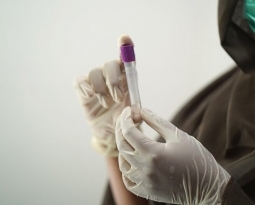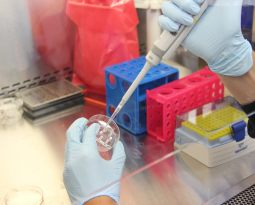Alabama Patent of the Month – February 2023
Cataract surgery is often needed when a patient’s eye lens becomes cloudy. Since the lens is needed to focus light and control vision, a cloudy lens compromises our sight. The surgery replaces this cloudy lens with an IOL. Traditionally, a soft IOL made of silicone elastomer or soft acrylic material is inserted into an eye through a small incision using an IOL delivery device. Reducing this incision size is crucial to reduce side effects. One way to reduce the size is to fold the IOL into a smaller size. Unfortunately, these smaller incisions may be more difficult to work with.
Manual delivery devices like syringes and screw-based devices are hard to control and can result in tearing or injury to the eye. Electrically, hydraulically, gas-driven, and spring-driven delivery mechanisms have been developed, but they often suffer from excess weight, poor balance, mechanical complexity, and high expenses. To streamline the procedure, IOLs are now prepackaged in cartridges with the folder already attached. The cartridges and folders are designed to work best with the lens design and simplify loading for the clinician.
Atrion Medical Products, Inc. has developed a novel IOL delivery device that overcomes the drawbacks of existing delivery mechanisms. The device is designed to insert an IOL into an eye through a small incision in a controlled and efficient manner, reducing the possibility of tearing or injury to the eye. The device has a macro movement actuator that moves the IOL into position, and a micro movement actuator which delivers the IOL into the eye. The device eliminates the need for manual operation, allowing the surgeon to quickly execute the procedure while freeing a hand to assist in the procedure. The device is also designed to simplify the loading process, reducing the risk of human error.
Atrion Medical Products’ new IOL delivery device is a game-changer for cataract surgery. It streamlines the procedure, reduces the possibility of complications, and allows for a more controlled and efficient insertion of the IOL into the eye. The device is a testament to the advancements in medical technology and its ability to improve the quality of life for people undergoing cataract surgery.
Are you developing new technology for an existing application? Did you know your development work could be eligible for the R&D Tax Credit and you can receive up to 14% back on your expenses? Even if your development isn’t successful your work may still qualify for R&D credits (i.e. you don’t need to have a patent to qualify). To find out more, please contact a Swanson Reed R&D Specialist today or check out our free online eligibility test.
Who We Are:
Swanson Reed is one of the U.S.’ largest Specialist R&D tax advisory firms. We manage all facets of the R&D tax credit program, from claim preparation and audit compliance to claim disputes.
Swanson Reed regularly hosts free webinars and provides free IRS CE and CPE credits for CPAs. For more information please visit us at www.swansonreed.com/webinars or contact your usual Swanson Reed representative.

















